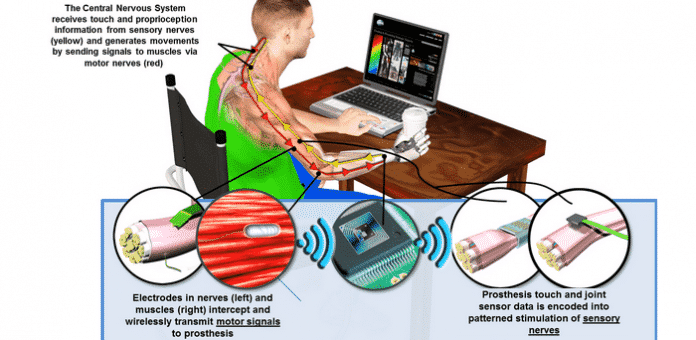HAPTIX project by DARPA conducts research to provide sense of touch in prosthetic hands
Despite of the modern researches in technology for upper-limb prostheses, artificial arms and hands, the technology has not yet evolved to provide the artificial limb users with sensory feedback, like the real world “feel” of things being touched or awareness of limb position and movement. Without this feedback, even a modernized prosthetic limb may feel dull to the maimed person, a factor that impairs the limbs’ effectiveness and their wearers’ willingness to use them.
In a order to overcome these challenges, DARPA has awarded prime contracts for Phase 1 its Hand Proprioception and Touch Interfaces (HAPTIX) program.
DARPA’s interest and assistance to HAPTIX to revive full and healthy functionality is because of scores of military personnel being wounded and maimed in battles and counter insurgency operations. The DARPA initiative is also a part of the White House programme for rehabilitation of Army veterans. However the military usage is often passed to common man as has happened with Internet and many modern technological innovations.
HAPTIX seeks to bring a prosthetic palm complement that moves and provides the user a feeling healthy hand. Sensory feedback, generally from a hand, is undeniably critical for many functions, and HAPTIX seeks to bring a feeling of knowledge so abounding and colourful that users would wish to wear their prostheses full time. By restoring feeling functions, HAPTIX also aims to revoke or discharge haunt prong pain that affects about 80 percent of amputees.
Speeding growth of vastly softened upper-limb prostheses has turned a inhabitant priority. President Obama referred to DARPA’s countless modernized prosthetics programs in his 2015 State of a Union residence final month when he pronounced a U.S. supervision is meddlesome in “creating insubordinate prosthetics, so that a maestro who gave his arms for his nation can play locate with his kids again” .
“The ultimate idea for HAPTIX is to create a device that is safe, effective and arguable adequate for use in bland activities,” stated Doug Weber, DARPA module manager. “DARPA is partnering with scientists during a Food and Drug Administration to assistance rise standards for verifying reserve and quantifying advantages of this new category of modernized technologies. We wish to streamline a routine of validating technologies that can assistance a troops, servicemen and veterans who have been harmed while serving a country.”
DARPA is evaluating several graphic technical approaches in Phase 1. Those that it infers as successful would continue into Phase 2, that would confederate comparison record components into a finish HAPTIX exam system. The group skeleton to trigger take-home trials of a complete, FDA-approved HAPTIX prosthesis is hoped to be completed within 4 years timeline.
The name HAPTIX is a play on a word haptics, referring to a clarity of touch. The module skeleton to adjust one of prosthetic prong systems grown recently underneath DARPA’s Revolutionizing Prosthetics module to incorporate interfaces that yield discerning control and feeling feedback to users. These interfaces would build on modernized neural-interface technologies being grown by DARPA’s Reliable Neural-Interface Technology (RE-NET) program.
Where appropriate, HAPTIX teams intends to procure commercially accessible technologies such as intramuscular electrodes and lead technologies grown primarily for cardiac pacemakers and now used in several complicated implantable medical devices. The module also skeleton to exam modernized microelectrode array and haughtiness slap electrode technologies that have been grown over a past dual decades with support from a National Institutes of Health, a Department of Veterans Affairs and DARPA.
DARPA is operative with teams led by a following institutions:
- Case Western Reserve University
- Cleveland Clinic
- Draper Laboratory
- Nerves Incorporated
- Ripple LLC
- University of Pittsburgh
- University of Utah
- University of Florida
To assistance a performers some-more fast and cost-effectively control their research, DARPA is providing prosthetics make-believe program for contrast designs. The program includes a various of a DARPA Robotics Challenge (DRC) Simulator from a Jun 2013 Virtual Robotics Challenge, that helped to assist a initial pattern and analysis of semi-autonomous robots that could assist in puncture response efforts.
“The DARPA Robotics Challenge Simulator was a large assistance for DRC and we immediately saw how bettering a practical contrast surroundings could advantage HAPTIX research,” Weber said. “The simulator will capacitate fast and low-cost growth of a HAPTIX record and also yield amputees with a picturesque knowledge for training to use their physical prosthesis.”
The good news is that some day, maimed persons could actually ‘feel’ how warm their coffee is and that would be a matchless moment for hundreds of physically handicapped people around the world.
Resource : DARPA.


